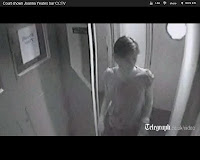“The first thing we do, let’s kill all the lawyers”
- Dick the butcher, one of Jack Cade’s rebels, in "Henry VI", Part 2,
attr. Wm. Shakespeare
This post contains a list summarising the items that made this an unfair trial, followed by a calendar listing all the speeches, testimony and other items making up the trial.
 |
| Bristol Crown Court (Photo: The Mail) |
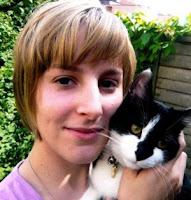 |
| The victim – Joanna Yeates |
The jury is sworn in
Potential jurors had to answer questions about whether they knew any of the trial witnesses or had links to the firms BDP (where the victim and her boyfriend worked), Buro Happold Ltd (where the defendant worked) or Dyson (where the defendant’s girlfriend worked). Jurors were also asked whether they had contact with police during the investigation into Joanna Yeates’s disappearance.
The jury consisted of 6 young local men and 6 young local women, all of them white. The balance between men and women was probably just a coincidence. Even so, in cases such as this, where the accused is not local, why is no effort made to achieve some measure of fairness, by ensuring that at least half of the jury’s members are non-local, non-white, non-youthful? In cases where the accused is a classic mobile EU migrant professional, why is no effort made to achieve some measure of fairness, by ensuring that some of the jury’s members are deliberately drawn from other EU member states? A juror who has lived in the same place all his life is unlikely to grasp the importance of evidence of the good character that was the basis on which a defendant who is otherwise unknown locally had been head-hunted to the neighbourhood by an employer.
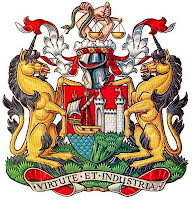 |
| The jury had a right to hear ALL the evidence, including Christopher Jefferies’s testimony about the persons he saw on the front path |
After the jury had been sworn in, the Judge, Mr. Justice Richard Field, warned its members not to do any research into the case, nor to look up old news reports on the internet about the investigation, nor to study news reports of the trial proceedings. Their verdict, he told them, must be based solely on the evidence they heard in court. The twelve youthful jurors must have wondered how this stern old lawyer could seriously expect them to forget the lurid reports (and lies) about the victim, the accused, their families and their friends that had been so firmly impressed on their memories by the frenzied news media day in, day out, less than one year earlier. They had a right to expect to hear ALL the evidence. Was the judge aware of the unreported deal between the lawyers that prevented the jurors from hearing any independent evidence of the defendant’s good character?
The jurors had been told to expect the trial to begin on Thursday, 6th October, 2011, but it was not until Monday, 10th October 2011, that Mr Nigel Lickley QC opened his case for the Prosecution. Sally Ramage (Criminal Law News, November 2014) reports that Mr William Clegg QC pleaded for more time to read the extra 1300 pages of evidence that the Prosecution had thrust upon the Defence at the last minute. These colour-coded pages formed a bound A3 document containing the timeline of the alleged murder, with details of every incident involving each of the four parties involved.
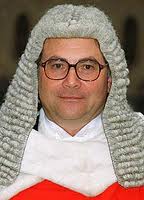 |
| Mr. Justice Field |
The naive majority
 |
| The bathroom in Joanna Yeates’s flat, where neither the jury nor the journalists could miss seeing the forensic chemical residues. |
 |
| 44 Canynge Road, Clifton |
The jury deceived and manipulated
 |
| Long Lartin Prison |
The headlines day by day
Here are the main headlines reporting what the jury heard on each day of Vincent Tabak’s “show trial”:Day 1: Cool Vincent Tabak went shopping with Jo’s body in the boot of his car.
Day 2: Cold, calculating Vincent Tabak tells girlfriend he is bored after killing Jo.
Day 3: Jurors’ poignant visit to flat where tragic Joanna was killed.
Day 4: Vincent Tabak drank champagne and told friends only a crazy, detached person could have killed Jo.
 |
| Jo’s parents arriving at the Court. Their testimony was never heard |
Day 6: Vincent Tabak strangled Jo for 20 seconds to stop her screaming.
Day 7: Vincent Tabak confessed to Salvation Army prison chaplain that he had killed Jo.
Day 8: Vincent Tabak surfed internet for unsolved murders and body decomposition.
Day 9: Vincent Tabak apologizes to Jo’s parents after admitting contemplating suicide.
Day 10: Vincent Tabak denies getting sexual thrill from strangling Joanna.
Day 11: Joanna’s neighbours did not hear her screams the night she was strangled.
Day 12: Vincent Tabak knew Joanna would die and could have let her live.
Day 13: Joanna’s murder was all about sex, says prosecutor.
How the trial was rigged
 |
| Prosecuting Counsel Nigel Lickley QC |
 |
| Defence Counsel William Clegg QC |
- Mr. Clegg made no attempt to plant the suggestion in the minds of the jury that the victim might have received some of her 43 injuries from someone other than his client, nor that the disorder in the flat might have been staged or invented.
Who or what caused her 43 injuries?
Mr. Clegg did not want the court to know. - Neither he nor the Counsel for the Prosecution Nigel Lickley QC made any attempt to establish by witness examination whether or not Vincent Tabak is a “crazy, detached person”.
- The Prosecution made no effort to establish a motive for the murder.
- Nor did they produce any evidence of any change in the defendant’s behaviour prior to the killing that might account for his sudden transformation from a gentle and conscientious person into a cold-blooded criminal with the intent to kill. Mr. Clegg failed to draw the jury’s attention to these factors in his closing speech.
- On the other hand the jury heard statements from seven witnesses to his behaviour after the killing and prior to his arrest.
- Thanks to an unreported agreement between the defence and the prosecution not to submit any independent character evidence, the only person who submitted evidence of the defendant’s professional and academic achievements, good character and sympathetic personality was Vincent Tabak himself when he went into the witness box. The defence failed to submit the good character testimony of any of the numerous credible witnesses who spoke favourably to the press about the defendant immediately after his arrest.

Tanja Morson’s
testimony was never heard - A characteristic of a “show” trial based on an unsound plea is the reiteration, day after day, of the accused’s wicked deeds, accompanied by the accused’s abject public remorse and humiliating acknowledgement of having committed disgusting and unforgiveable acts. The wretched defendant played his humiliating role to perfection by standing trial on the basis of a defence statement derived from an improbable theory that had been published in The Mirror nine days before his arrest and attributed to unnamed detectives.
- A total of 19 prosecution witnesses testified during the trial, and there were 17 witnesses statements read out in court on behalf of the prosecution. Apart from the defendant himself, Mr. Clegg called only one witness for the defence, and that was the pathologist Nat Cary, whom he had inherited from Crossman’s defence team. He also produced one witness statement from Geoffrey Hardyman. The judge failed to explain to the jury that a statement not made in oral evidence is hearsay.

Christopher Jefferies’s
testimony was never heard - The jury did not hear ALL the evidence. Despite being conspicuous persons in the case, the testimony of neither Christopher Jefferies, Tanja Morson, nor David & Teresa Yeates was heard in any form. If the court had heard the landlord’s two witness statements, the case against the defendant would have collapsed.
- The court was told in detail about the dog-walkers who allegedly discovered Joanna’s body on the verge of a country lane, and about the straps and broom-handle used in raising it from the ground, but the jury did not hear about the four pumping tenders and 23 fire & rescue officers actually called out to recover her body from somewhere that must have been obviously much less accessible than the court heard.
The jury never heard about the four
pumping tenders and 23 fire & rescue
officers called out to recover the body - Mr. Clegg had rehearsed beforehand with them the questions he would put to two key prosecution witnesses, namely forensic scientist Lindsay Lennen (whose unsound DNA evidence he chivalrously helped her justify) and prison officer masquerading as a chaplain Peter Brotherton (with whom he contrived the defendant’s false confession). Mr. Justice Field failed to stop Mr. Clegg from deceiving and manipulating the jury by his cross-examination methods.

Vincent Tabak
explaining how crowds
of people flow in
mosques and
other public spaces - The prosecution showed jurors several videos from CCTV showing Joanna Yeates and Greg Reardon setting off for work through the snow together on the day it was alleged that she was killed and of the cheerful victim that same evening, and numerous gruesome photos of her body after it was found. Jurors were also shown videos from CCTV of Vincent Tabak striding through the Asda supermarket like a zombie at a time when the prosecution claimed he had her body in a car outside. The defence made no attempt to redress the balance by showing videos of the cheerful defendant playing with his seven nieces and nephews, doing research at Eindhoven University, being awarded his Ph.D or explaining to clients all over the world how to use his employer’s advanced computer simulation products.
- Some of the videos shown to the court had evidently been edited, and at least one had been manipulated to remove the timestamp. No named witness under oath (in court or outside) testified to the integrity of these videos as evidence.
- No witness under oath testified to the integrity of the e-mail exchanges between the defendant and his girlfriend nor of the evidence of the victim’s brief visits to three different shops during her walk home.
- On the 3rd day of the trial, showman William Clegg QC sent the jurors on a trail of “murder tourism” on the pretext of evaluating whether screams from inside Joanna’s flat could have been heard across the road. His real intention was to whip up their passions at what they had been deceived into believing was the scene of the tragedy.

If Joanna really had been killed here, then scientists
would have found traces of her blood and Vincent
Tabak’s DNA in her flat, and the jury would
certainly have been told this - Despite the enormous and prolonged scientific presence, there was no expert witness testimony to the results of the forensic examination of Joanna’s flat. Had she been killed there by Vincent Tabak, as he alleged in his implausible testimony, then traces of her blood and his DNA would have been found there, and the court would certainly have been told this.
- Mr. Clegg admitted a Prosecution forensic statement that 11 fibres alleged to come from Vincent Tabak’s black coat were found on Joanna’s body (according to Sky News on Twitter). This meant that the jury did not hear arguments about the probability that these fibres emanated from this particular coat rather than from a garment worn by a customer in the Bristol Ram pub or any other person who might have dumped the body after vainly trying to lift it up over a stone wall. Such an action would certainly have left some traces of Joanna’s blood on the killer’s clothes, yet the court was not told about any results yielded by the forensic examination of Vincent Tabak’s glasses, his black coat and other clothes, and the interior of Tanja Morson’s Renault Megane, to which traces would have been transferred from his clothes.

The evidence of the fibres alleged
to come from his black coat
was never tested - There was no statement about the alleged telephone tip-off from the sobbing girl on 19th January 2011 that an unnamed police press spokesman at the time had alleged led them to arrest the defendant. Instead, the court heard that it had been the “incriminating” behaviour of the defendant and of the women accompanying him to Schiphol three weeks earlier that had first aroused the police’s suspicions.
There were so many holes in the trial of Vincent Tabak that it resembled an Emmental cheese.
Accredited journalists were authorised to tweet the proceedings from the Court, but members of the public were forbidden even to take notes on paper. At one point, Judge Field stopped the trial and instructed an usher to remind an elderly man in the public gallery, George W., who was writing, of this exceptional prohibition. It can have had only one purpose, namely, to release the court from the obligation to conduct its proceedings with transparency.
If you have tears, prepare to shed them now
On 14th October 2011 the jury were also shown a succession of gruesome photos of Joanna's blood-stained body and her injuries. The Home Office pathologist told the court that bruising can occur only while the heart is beating. The media never questioned the validity of the defendant’s faked confession, and the journalists implied that the tears he shed in court were due to remorse over his deed. His tears were more likely to be due to the realisation that, after seeing in court the injuries Joanna had sustained, of which he had not been forewarned, and for which he had prepared no defence, the jury would never accept the unsound manslaughter plea for which he had been tricked into standing trial by his own defence lawyers.Forgive them, for they knew not what they were doing
“It is by no means easy to be a good listener... For most people it needs long and patient training... But a man who has been trained for years to listen to evidence in the Law Courts has learnt to pay careful attention to what he hears, and to try to interpret it... To listen with a real intention to understand needs for most people a big effort of attention and concentration, which some are unable or unwilling to give.” (The Rt. Hon. Sir Alfred Bucknill, 1953)
Being a jury member is one of the most stressing functions in a criminal trial, with the exception of the defendant. Everyone else in court has some stress-relieving activity to perform from time to time, but the jury is completely passive and must concentrate on the evidence they hear. Vincent Tabak’s prosecution successfully alleviated the jury’s stress by treating them to a soap opera in which the details of the evil defendant’s appalling treatment of the hapless victim was reiterated day after day.
There is nothing to like about my client
For a defendant with Vincent Tabak’s background his defence QC had exceptionally comprehensive evidence of irreproachable good character on which he could have drawn to mitigate the disgusting picture painted by the prosecution, yet Mr Clegg had understaken to throw his client to the wolves by entering into an unreported prior deal with the prosecution on zero character evidence. |
| The jury heard no evidence of the defendant’s good character from his employer Dr. Shrikant Sharma |
Why did he slay this fragrant English rose?
 |
| The entrance to Durnford Quarry in Longwood Lane. The jury was taken to see the spot where they were told Joanna’s body had been dumped |
From The Guardian: Earlier on Friday [28th October 2011], the jury had passed a handwritten note scribbled on a page of a torn-out notebook to [Mr. Justice] Field. In response to the note, the judge repeated parts of his summing up relating to the intention of Tabak, a Dutch engineer. [Mr. Justice] Field told the six men and six women on the jury that the issue to be decided was the defendant’s intention when he used “unlawful violence” against Yeates. The question they had to address was: “Did he intend to kill her or cause her really serious bodily harm?” [Mr. Justice] Field told them they had to examine the evidence they had heard. “I emphasise it is the evidence you heard and nothing else.” The judge said if the jury was sure that, when he strangled Yeates, Tabak had intended to kill her or cause her really serious harm, the verdict would be guilty. If they were not sure, it had to be not guilty.
The trial judge, Mr Justice Field, called the jury back into court one at Bristol crown court at noon after it had been deliberating for 11 hours. He told the jury to continue to try to reach a unanimous verdict on whether Tabak was guilty of murdering Joanna Yeates. But he said if they could not, he would accept a verdict on which at least 10 agreed. The jury was sent back to continue deliberating.
Four of the jurors had wanted to return a verdict of Manslaughter, but two of these were at length persuaded by the other eight to vote for a verdict of Murder before they eventually returned a 10-2 majority verdict after nearly 14 hours’ deliberation. In returning a verdict of Murder, these ten jurors decided that Vincent Tabak intended to kill Joanna Yeates. As they were aware that he did not assault her sexually, why did they reach that conclusion? The evidence heard in court had given them no clue to the basis for the intent that they decided he must have had. Did these jurors guess that his intentions were connected with robbery, a ransome demand, blackmail, drugs trafficking, illegal bribery of an overseas architectural client, spying for a secret agency, organized crime, mistaken identity by a contract killer, or what?
The orgy of humiliation
 |
| An orgy of humiliation |
The orgy of the public humiliation of Dr. Tabak as an alleged sexual pervert with a strangulation fetish after the trial was deliberately instigated by the judge in collaboration with the prosecution and the defence. It had the effect of giving the news media a very strong incentive never to reveal this obvious miscarriage of justice. If Dr. Tabak ever lifts his head again, the media all risk libel settlements that would make the landlord’s look like pin money by comparison. The judge’s purpose in instigating the orgy of humiliation was probably also to prevent the members of the jury from working out after the trial that they had convicted an innocent man.
 |
| Brunel’s suspension bridge across the Avon Gorge at Clifton, now blighted by the scapegoating of Vincent Tabak |
Calendar of the trial in Bristol Crown Court October 2011
Tuesday 4th October
- 18 jurors selected and addressed by the judge Mr. Justice Field in the presence of Vincent Tabak.
Wednesday 5th October
- 18 jurors addressed by the judge in the presence of Vincent Tabak.
- Prosecutor Nigel Lickley QC makes a failed application to have his allegations of the defendant’s viewing of adult pornographic videos admitted as evidence.
Thursday 6th October
- 12 jurors sworn in, in the presence of Vincent Tabak
Monday 10th October (Day 1)
- Jurors see videos from CCTV of Joanna Yeates and Greg Reardon going to work on the day the Prosecution claimed she was killed.
Joanna Yeates in the Bristol Ram - Jurors see videos from CCTV of Joanna Yeates inside the Bristol Ram pub.
- Jurors see a photo of Joanna’s blood-stained pink top.
- Jurors see a video from CCTV of Joanna Yeates in Waitrose.
- Jurors see a video from CCTV of Joanna Yeates buying two bottles of cider in Bargain Booze in Regent Street, Clifton Village.
- Jurors see a video from CCTV of Joanna Yeates buying a pizza in Tesco Express in Regent Street, Clifton Village.

Joanna Yeates entering Waitrose - Jurors see a video from CCTV of witnesses who heard Joanna scream on the night she died.
- Jurors see a video from CCTV showing a cyclist alleged to be Vincent Tabak on his way home from Temple Meads Station.
- Jurors see a video from CCTV of a car alleged to be a silver Renault Megane driven by Vincent Tabak through Bristol around 10 p.m.
- Jurors see videos with a date-stamp but no time-stamp from CCTV of Vincent Tabak in Asda.

Joanna Yeates
entering Bargain Booze - Jurors see videos from CCTV of a car alleged to be a silver Renault Megane driven by Vincent Tabak along roads allegedly leading to Longwood Lane.
- The court was shown a clip from CCTV showing Vincent Tabak and Tanja Morson arm-in-arm at a fast food outlet where they made a brief stop on their way home after he had collected her after her works party.
- The court heard details and a
muffled transcript of Greg Reardon’s 999 call to police at 00.45am on the 20th December 2010, in which he said his girlfriend was missing.
Vincent Tabak in Asda. There is a blur at the lower
left-hand corner of the video, where the time of
capture should have been visible. - Vincent Tabak’s and Tanja Morson’s email exchanges at work in the week after the killing are read out.
- The court was shown photographs of the place where Joanna’s body was alleged to have been dumped.
- The court was shown photographs of the inside of Joanna Yeates’s flat. These showed the boots she wore the evening she was at the Bristol Ram pub, and her purse on the table.
- The court was shown photos of the body covered in snow.
Tuesday 11th October (Day 2)
- Mr Nigel Lickley QC continues his opening case for the prosecution.

The Renault Megane - The court was shown photos of Joanna’s blood on the wall in Longwood Lane.
- The jury was shown photos of the Renault Megane, including the empty boot that the prosecution says was used to dump JoannaYeates’s body.
- Mr. Lickley concludes his opening speech.
- Mr Clegg invites jurors to doubt if screams from inside the flat could be heard.
Wednesday 12th October (Day 3)
 |
| Inside Joanna Yeates’s flat at 44 Canynge Road. Was the use of dangerous chemicals inside the flat just for show, or had technicians been told to eliminate possible forensic traces permanently? |
- Jurors visit Longwood Lane and retrace the last leg of Joanna Yeates’s route home from the Hophouse Pub to 44 Canynge Road, Clifton, together with the judge and journalists, but without Vincent Tabak.
Thursday 13th October (Day 4)
- Nicholas Rowland was the prosecuting junior counsel who conducted the jury through the day’s witnesses.
- Darragh Bellew, a landscape architect who had been at the Bristol Ram with Joanna, testifies that she told him she planned to bake some cakes and bread. He also testified that Greg Reardon had rung him at around midnight on 19th Dec. 2010 to tell him that she was missing.

Darragh Bellew - Jurors saw a video from CCTV showing Darragh Bellew and Joanna leaving their office on Park St. and using a cashpoint before walking on to the Bristol Ram.
- Statement from Michael Brown, architectural assistant at BDP, read out. He recounted that she told him that she didn’t have any plans for the weekend, talked about her plans for Christmas, and appeared bored.
- Statement read out from architect Samuel Huscroft, who was not at the Bristol Ram, but had received a text from Joanna.
- Statement read out from Peter Lindsell, a former BDP employee, who said that Miss Yeates texted him that night.
- Statement read out from Matthew Wood, a friend of Miss Yeates’s brother Chris, who had exchanged texts with Joanna.
- Father George Henwood told the court that he had set out on his usual dog walk and had exchanged words with a young woman who he later realised must have been Joanna.
- Mr. Clegg cross-examined Fr. Henwood.
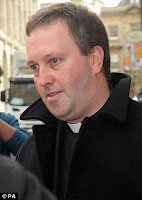
Fr. George Henwood - Statement read out from office manager Elizabeth Chandler about Joanna dreading the weekend on the evening of 17th December 2010.
- Statement read out from teacher Matthew Philips that he heard a commotion from across the road while waiting to go into the house at 53 Canynge Road.
- Statement read out from Warren Sweet that he arrived at the same party together with Matthew Phillips at about 8.30 p.m. but heard neither screams nor a commotion.
- Harry Walker testified about screams while he was watching TV with his fiancée.
- Statement read out from Andrew Lillie, host of the dinner party on 15th January 2011. He recounted that Vincent had tried to lighten the atmosphere by telling them that the police had searched his and Tanja’s flat before Christmas, “opening a drawer so they could look for a body.”
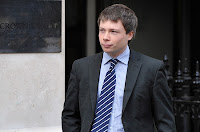
Harry Walker - Statement read out from Sarah Maddock, a solicitor, recounting the defendant’s remark about “a crazy detached person”, and that Vincent Tabak & Tanja Morson had held hands under the table at a dinner party on 15th January 2011.
- Statement read out from Louise Apthorpe, testifying that Vincent Tabak was cheerful at the dinner party on15th January 2011. She reported that Tanja Morson had told the other guests about their Schiphol interview, where she felt that her own words had been twisted by the police. Dr. Abthorpe recalled commenting that evening: “I wonder how the murderer must be feeling... If it was me, I wouldn’t be able to sleep”.
- Florian Lehman testified about screams coming from the direction of 44 Canynge Road.
- Zoe Lehman testified about screams coming from the direction of 44 Canynge Road.
- Mr. Clegg cross-examined Zoe Lehman.
- Statement from Linda Marland read out about Vincent Tabak’s having been silent and “disinterested”at her daughter’s 24th birthday party on18th December 2010.
Friday 14th October (Day 5)
- The judge told the jurors that “in the interests of justice” they would have to see the images of Joanna’s body.

Dr. Russell Delaney - Statement read out from Daniel Birch whose dog Roxy he and his wife had been walking when they found the body.
- Statement read out from the first police officer on the scene, Martin Faithfull.
- Home Office pathologist Russell Delaney described the body.
- Forensics co-ordinator Andrew Mott, who had been among the first to be called to the scene in Longood Lane on 25th December 2010, recounts the precautions he took and the method he used to remove the body, which had been frozen to the ground.
Andrew Mott - Mr. Clegg cross-examined Andrew Mott.
Monday 17th October (Day 6)
- Mr Lickley questioned Russell Delaney.
- Mr Lickley read out extracts from a statement signed by Vincent Tabak on 22nd September 2011 describing how Joanna came to be strangled.
- Mr William Clegg QC questioned Russell Delaney.
- Rebecca Scott, Joanna Yeates’s best friend, testified.

Rebecca Scott - Greg Reardon testified before and after lunch about his departure for Sheffield and
the state of the flat on his return. Just before the adjournment for lunch, the court was shown a video from CCTV showing Joanna Yeates and Greg Reardon setting off for work through the snow on the day she was killed. During his testimony the court was shown a drawing he had made to illustrate where items were found in the flat on his return.

Greg Reardon - Mr. Lickley cross-examined Joanna’s boyfriend.
- DC Karen Thomas testified about her two interviews with Vincent Tabak, including her trip to Schiphol.
- A statement from police officer Anneliese Jackson was read to the court about her being called out to
Canynge Road following Greg Reardon’s missing persons phone call. The jury was sent out while a point of law was discussed. Then her second statement was heard. Then the jury was sent out again.
DC Karen Thomas - A statement from DC Simon Mills was read out about his interview with Vincent Tabak and Tanja Morson about their movements on the evening Joanna Yeates disappeared. It is not clear when this interview took place.
- A statement from Shrikant Sharma was read out about Vincent Tabak’s difficulty in concentrating at work. Tabak asked his team leader to go easy on him, as he was under stress from the investigation.
Tuesday 18th October (Day 7)
- The jury heard about Vincent Tabak’s questioning after he was arrested.

Forensic Archaeologist
Dr. Karl Harrison - A statement was read out by forensic archaeologist Dr. Karl Harrison, a Forensic Archaeologist at Cranfield University, describing how Joanna’s body was covered with leaves.
- A photo of Joanna’s body, lying fully clothed in the foetal position, with her pink top pushed up, was shown to the jury while forensic scientist Tania Nickson (School of Defence & Security, Cranfield University, Shrivenham) testified about the bloodstain on the wall in Longwood Lane.
- Mr Clegg cross-examined Tania Nickson briefly.
Tania Nickson - Lindsay Lennen, a body fluids and DNA specialist on the staff of LGC Forensics, testified about the DNA evidence.
- Mr Clegg cross-examined Lindsay Lennen.
- DC Geoffrey Colvin testified about how he arrested Vincent Tabak and took him to Trinity Road police station.
- Statement read out from nurse Ruth Booth-Pearson about her
medical examination of Vincent Tabak.
- Salvation Army prison chaplain Peter Brotherton testified about his three conversations in
prison with Vincent Tabak.

Lindsay Lennen - Mr Clegg cross-examined Peter Brotherton.
- Dr Jennifer Miller (director at Northlight Heritage, Glasgow) testified about the contents of Joanna’s stomach.
- Maria and Peter Brown both gave statements saying people had attended a Christmas party they held at their top-floor flat, opposite Miss Yeates’s flat, on the night she disappeared.
- Statement read out from Glen O’Hare, a lecturer friend of Tanja Morson’s, about the defendant’s behaviour at a dinner party that the witness had hosted on 20th December 2010.

Peter Brotherton. He did not tell
the jury that he is a high ranking
prison officer from another prison - Admissions: Statement about 11 fibres alleged to be from Vincent Tabak’s black wool coat found on Joanna’s body and an alleged match between other fibres found on her clothes and body and the lining of the boot of the car he was driving (according to Sky News on Twitter).
- DC Richard Barnston testified about his tape-recorded interview with Vincent Tabak following his arrest.

DC Paul Derrick - DC Paul Derrick testified, denying that there was tension between himself and Vincent Tabak’s female duty solicitor.
- Mr Clegg cross-questioned DC Paul Derrick as to whether she was out of her depth – “No”.
Wednesday 19th October (Day 8)
- Statement from PC Steve Archer, who was guarding 44 Canynge Rd on 2nd January 2011 when the defendant and his girlfriend came to pick up some things.
- Prosecutor Nigel Lickley QC makes a failed application to have his allegations of the defendant’s viewing of adult pornographic videos admitted as evidence.

Lyndsey Farmery.
She did not tell the
jury that she is a
Criminal Intelligence
Analyst - Jury heard from Mr Lickley and Lyndsey Farmery that Vincent Tabak looked up all sorts of things on the internet.
- DC Mark Luther, officer in charge of the case, takes the jury through photos of Vincent Tabak’s flat.
- Mr Clegg opens the case for the defence.
Thursday 20th October (Day 9)
- Vincent Tabak testifies for his first day as a witness, prompted by Mr. Clegg to talk about his life, education, career and girlfriend prior to the day of Joanna's death.
- Mr. Clegg cross-examined him about the death of Joanna and his disposal of her body.
- Mr Lickley cross-examined Vincent Tabak about his meeting with Joanna.
Friday 21st October (Day 10)
- Mr Lickley cross-examined Vincent Tabak, on his second day as a witness, about his meeting
with Joanna and how she came to be strangled.
Dr. Nat Cary - Mr Lickley cross-examined Vincent Tabak about his dumping of the body.
- The court was shown a photo taken of the scar on Vincent Tabak’s arm after he had been arrested.
- Dr Nat Cary testified about his examination of the body for the defence.
- Mr Clegg cross-examined Dr Nat Cary.
- The court was shown a close-up photo of Joanna’s face, a photo of an abrasion over Joanna’s lip, a photo of an injury on the left side of Joanna’s collar bone, a photo of marks on the back of her neck, photos of injuries on Joanna’s “trunk”, a photo of a clear mark on Joanna’s right wrist, a photo of Joanna’s left arm, showing marks on her left hand, a photo showing the marks on Joanna’s ankle.
- Mr. Lickley cross-examined Dr. Nat Cary.
- The court was shown a photo of an abrasion on Joanna’s cheek.
Monday 24th October (Day 11)
- Statement from Geoffrey Hardyman read out to jurors by junior defence counsel Dean Armstrong that he did not hear screams.
Geoffrey Hardyman - Mr Clegg formally closed the case for the defence.
Tuesday 25th October (Day 12)
- Mr. Lickley is believed to have made a failed application to cross-examine the defendant about his alleged contacts to call-girls.
- Mr Lickley delivered his final speech to the jury.
- Mr Clegg delivered his summing-up speech to the jury, “I am not going to ask you to like my client…”
- Interesting arguments between Mr Lickley and Mr Clegg about contested points relevant to the intent to kill etc.
Wednesday 26th October (Day 13)
- Mr Justice Field summed up the case.
- The jury began their deliberations.
Thursday 27th October (Day 14)
- The jury remained out.
Friday 28th October (Day 15)
- The jury passed a handwritten note to Mr. Justice Field.
- In response to the note, the judge repeated parts of his summing up.
- The jury deliberated.
- The judge called the jury back at noon. He told the jury to continue to try to reach a unanimous verdict, but if they could not, he would accept a verdict on which at least 10 agreed.
- The jury was sent back to continue deliberating.
- The jury delivered its verdict.
- Sentence was passed.


